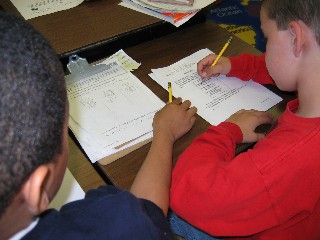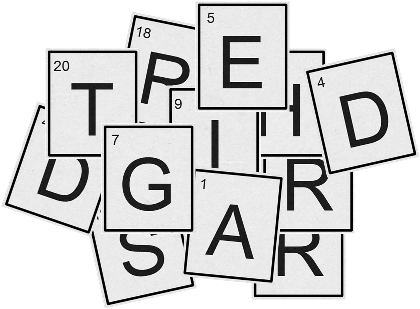The NCTM Illuminations site offers Coin Box, an application that allows students to count money, using coins and/or coins on the hundred board. The app allows students to move the coins as they count. Students may opt to place similar coins in a row for easier counting, etc. The game also prompts students that their answer is too little or too much, allowing them to try again.
Students may use this application in school or at home to practice counting money, making change, and exchanging coins. Be sure to include this free site in resources for parents.

Monday, September 26, 2011
Wednesday, September 7, 2011
School Day Count Routine
Each day a student adds one straw or craft stick to the ones pocket or cup. The student holds up each straw in the ones pocket and leads the class in an oral count. The student and class decide if they have enough straws to make a bundle (of ten) to move to the tens place. Students will quickly begin to make predictions that "tomorrow is a bundle day" or "Friday will be a bundle day."
After leading the class in an oral count of straws in all pockets, the student makes the change in the posted number so that it reflects how many days they have been in school and how many straws they have collected in the school day count pockets. If students use labeled cups to hold straws, then use a school day count poster to write the days. Laminate the poster and let students use dry-erase markers to change the number of days.
After leading the class in an oral count of straws in all pockets, the student makes the change in the posted number so that it reflects how many days they have been in school and how many straws they have collected in the school day count pockets. If students use labeled cups to hold straws, then use a school day count poster to write the days. Laminate the poster and let students use dry-erase markers to change the number of days.
- Download a School Day Count poster that may be laminated or inserted in a sheet protector so that students may use dry erase markers to record the appropriate digits for the day's count.
Tuesday, September 6, 2011
Back-to-School Problem Solving
September is a great time for data collection activities as students are naturally curious about their new classmates. Ask questions that require students to analyze data and support their conclusions.
Challenge students to solve some of these problems to practice collecting, organizing and analyzing data in real-life applications. Require students to explain their reasoning and solution to develop mathematical communication skills.
See all Back-to-School Word Problems.
Here's a sample 3rd grade problem that targets student understanding of probability:
Third graders cut apart each of the letters in THIRD GRADERS and place
the squares in a bag. Kevin pulls out one square and looks at the letter.
- What is the probability that the letter he pulls out will be the letter, D? Explain how you know.
- What is the probability that the letter he pulls out will be S? Explain.
- On Friday, his teacher says that if anyone can correctly predict which tile he or she will pull out the bag of THIRD GRADERS squares, the class will not have any homework over the weekend. She asks Kevin's table to predict for the class. They are nervous because the class is counting on them to say the right letter.
- Which letter should Kevin’s team predict that they will pull from the bag?
- Explain how you know that the students should predict this letter.
Note: It is very important that students explain how they know their answers are correct. They may use pictures, words and numbers to explain their thinking.
Labels:
back to school,
data analysis,
probability,
problem solving
Saturday, September 3, 2011
Math Train
Eric Marcos, a math teacher at Lincoln Middle School in Santa Monica, California, supports students as they create their own videos of important math concepts and skills. Math Train is the result of this classroom initiative in which students teach students. Here's how Math Train started:
Bookmark this site for middle school students and their parents. Chances are when a student runs into difficulty at home, he just might find an appropriate video that deals with that concept on Math Train.
Bookmark this site for middle school students and their parents. Chances are when a student runs into difficulty at home, he just might find an appropriate video that deals with that concept on Math Train.
Friday, September 2, 2011
What's Your Favorite Number?
Alex Bellos is fascinated with numbers. As an author of books on numbers, he's been asked countless times what his favorite number is. He decided to conduct a survey to find out what numbers people most liked. He promises to publish the results of this worldwide survey in 2012.
Students can also take part in the survey which simply asks you to input your favorite number and explain why it is your favorite. It would be fun for students to take part in this easy survey and they'd surely be interested in the results when they are available. Visit the Alex Bellos Blog to read about the survey idea and to enter your favorite number.
Extension: Extend this online activity by conducting a classroom survey of favorite numbers. You might use the same format that Bellos uses online. Students would collect data, then organize the data presenting it in graphical form before analyzing the results. Students might elect to organize a schoolwide survey to see if the classroom results match this larger sample.
Students can also take part in the survey which simply asks you to input your favorite number and explain why it is your favorite. It would be fun for students to take part in this easy survey and they'd surely be interested in the results when they are available. Visit the Alex Bellos Blog to read about the survey idea and to enter your favorite number.
Extension: Extend this online activity by conducting a classroom survey of favorite numbers. You might use the same format that Bellos uses online. Students would collect data, then organize the data presenting it in graphical form before analyzing the results. Students might elect to organize a schoolwide survey to see if the classroom results match this larger sample.
Subscribe to:
Posts (Atom)





